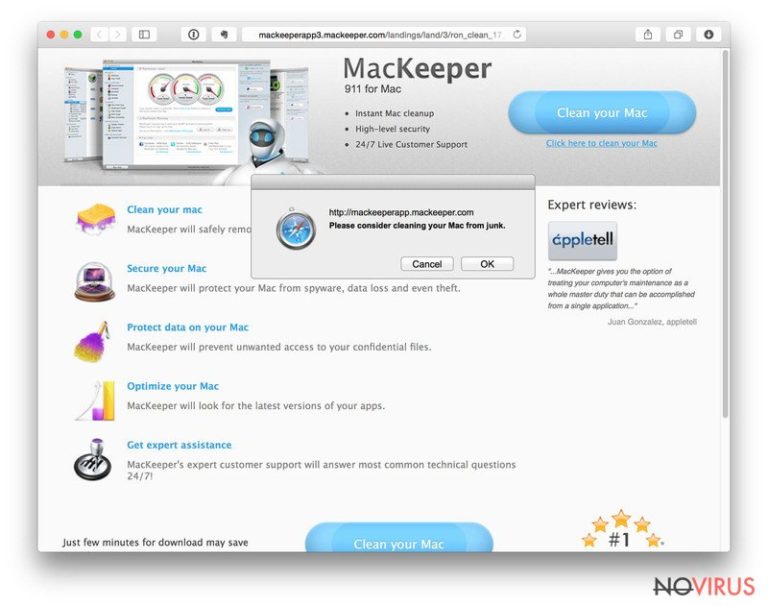Uninstall MacKeeper pop-up ads (Sep 2017 updated) - Chrome, Firefox, IE, Edge
MacKeeper pop-up ads Removal Guide
Description of MacKeeper pop-up ads
Why do I see MacKeeper ads?

MacKeeper is anti-virus software that has been causing troubles for Mac users for a couple of years. The program is legitimate; however many users claim that they haven’t installed it, but it still appeared on their computer and delivers an excessive amount of ads. Online you can find many negative comments about this program: MacKeeper virus, a scam, impossible to remove, and sometimes, the program is blamed for deleting user’s files.
Originally the program was created by Zeobit. However, after several issues and problems, developers sold the program for the company called Kromtech in 2013. IT specialists categorised this program as adware because it provides lots of advertisements. Users agree that one of the main issues is MacKeeper pop-up ads that offer purchasing program’s updates. We firmly recommend do not click on these ads do not buy anything.
So, you might lose the money and cause yourself more troubles. Unfortunately, users cannot just uninstall the program and get rid of the ads easily. To remove MacKeeper from your computer, you should use reliable software such as AdwareMedic and WebRoot.
The only way to download the legitimate program is from its official website. If you did it, probably you don’t see annoying and aggressive advertisements in the browser. However, many suspicious sites are offering to download this program too. These third-party domains might be malicious and offer you corrupted program’s version.
The creators of MacKeeper claim that all these advertisements, redirects, and other difficulties caused by their software are just competitor’s dirty job. So, the developers are aware of misleading ads by MacKeeper, but they do not take responsibility. Is it true?
Maybe, the competitors have actually cloned this application and spread annoying MacKeeper; maybe the developers secretly use aggressive marketing method as a method of distribution and lie to the users. No one knows the truth. However, if these ads are disturbing you, we recommend considering MacKeeper removal.

I haven’t downloaded the program. How did it end up on my computer?
The majority of users’ complaints were about the program’s distribution methods. No one is pleased that software was installed on their computers without their permission. Mostly, MacKeeper hijack might occur when users download and install programs such as MacSheild, MacProtecter, and Nauseum.
This aggressive marketing method is called ‘bundling.' The potentially unwanted program is added as ‘optional install’; however, often users have no clue about these optional programs because they use ‘Basic’ or ‘Quick’ installation mode. So, MacKeeper adware probably sneaked into your computer with the last installed program. You can avoid these programs if you choose ‘Advanced’ or ‘Custom’ installation mode. Then, you can deselect all unwanted programs.
The best ways for MacKeeper removal
As we mentioned before, many users have claimed that they faced troubles in removing the program. Our IT specialists prepared manual MacKeeper removal. So, if you feel capable of removing the app by yourself, follow our instructions provided at the end of the article. Additionally, you can remove MacKeeper automatically. This method requires using a reputable anti-malware program and running a full computer’s system scan.
If you are still thinking about manual removal way to get rid of MacKeeper ads from Windows, use the following steps:
- Click “Start” -> “Control Panel” -> “Uninstall a Program”
- Wait for the “Add/Remove Programs” window and select every entry related to MacKeeper
- Click “Uninstall” and OK to confirm the changes.
You may remove virus damage with a help of FortectIntego. SpyHunter 5Combo Cleaner and Malwarebytes are recommended to detect potentially unwanted programs and viruses with all their files and registry entries that are related to them.
Getting rid of MacKeeper pop-up ads. Follow these steps
Uninstall MacKeeper pop-up in Mac OS X system
To remove MacKeeper from Mac, you can rely on these instructions:
-
Users who use OS X should click on Go button, which can be found at the top left corner of the screen and select Applications.

-
Wait until you see Applications folder and look for MacKeeper pop-up or any other suspicious programs on it. Now right click on every of such entries and select Move to Trash.

Delete MacKeeper pop-up ads from Microsoft Edge browser
Delete suspicious extensions from MS Edge:
- Go to the Menu by clicking on the three horizontal dots at the top-right.
- Then pick Extensions.

- Choose the unwanted add-ons on the list and click on the Gear icon.
- Click on Uninstall at the bottom.
Clear cookies and other data:
- Click on the Menu and from the context menu select Privacy & security.
- Under Clear browsing data, select Choose what to clear.

- Choose everything except passwords, and click on Clear.
Alter new tab and homepage settings:
- Click the menu icon and choose Settings.
- Then find On startup section.
- Click Disable if you found any suspicious domain.
Reset MS Edge fully:
- Click on the keyboard Ctrl + Shift + Esc to open Task Manager.
- Choose More details arrow at the bottom.
- Go to Details tab.

- Now scroll down and locate every entry with Microsoft Edge name in it.
- Right-click on each of them and select End Task to stop MS Edge from running.
When none of the above solves the issue, you might need an advanced Edge reset method, but you need to backup your data before proceeding.
- Find the following folder on the PC: C:\\Users\\%username%\\AppData\\Local\\Packages\\Microsoft.MicrosoftEdge_8wekyb3d8bbwe.
- Press Ctrl + A on your keyboard to select all folders.

- Right-click on the selection and choose Delete
- Right-click on the Start button and pick Windows PowerShell (Admin).

- Copy and paste the following command, and then press Enter:
Get-AppXPackage -AllUsers -Name Microsoft.MicrosoftEdge | Foreach {Add-AppxPackage -DisableDevelopmentMode -Register “$($_.InstallLocation)\\AppXManifest.xml” -Verbose
Instructions for Chromium-based Edge
Delete extensions:
- Open Edge and click Settings.
- Then find Extensions.

- Delete unwanted extensions with the Remove.
Clear cache and site data:
- Click on Menu and then Settings.
- Find Privacy and services.
- Locate Clear browsing data, then click Choose what to clear.

- Time range.
- Click All time.
- Select Clear now.
Reset Chromium-based MS Edge browser fully:
- Go to Settings.
- On the left side, choose Reset settings.

- Select Restore settings to their default values.
- Click Reset.
Delete MacKeeper pop-up from Mozilla Firefox (FF)
Remove suspicious Firefox extensions:
- Open Mozilla Firefox browser and click on the three horizontal lines at the top-right to open the menu.
- Select Add-ons in the context menu.

- Choose plugins that are creating issues and select Remove.
Reset the homepage on the browser:
- Click three horizontal lines at the top right corner.
- This time select Options.
- Under Home section, enter your preferred site for the homepage that will open every time you launch Mozilla Firefox.
Clear cookies and site data:
- Click Menu and pick Options.
- Find the Privacy & Security section.
- Scroll down to choose Cookies and Site Data.

- Click on Clear Data… option.
- Click Cookies and Site Data, Cached Web Content and press Clear.
Reset Mozilla Firefox:
If none of the steps above helped you, reset Mozilla Firefox as follows:
- Open Mozilla Firefox and go to the menu.
- Click Help and then choose Troubleshooting Information.

- Locate Give Firefox a tune-up section, click on Refresh Firefox…
- Confirm the action by pressing on Refresh Firefox on the pop-up.

Chrome browser reset
Find and remove suspicious extensions from Google Chrome:
- In Google Chrome, open the Menu by clicking three vertical dots at the top-right corner.
- Select More tools > Extensions.
- Once the window opens, you will see all the installed extensions.
- Find any suspicious add-ons related to any PUP.
- Uninstall them by clicking Remove.

Clear cache and web data from Chrome:
- Click the Menu and select Settings.
- Find Privacy and security section.
- Choose Clear browsing data.
- Select Browsing history.
- Cookies and other site data, also Cached images and files.
- Click Clear data.

Alter settings of the homepage:
- Go to the menu and choose Settings.
- Find odd entries in the On startup section.
- Click on Open a specific or set of pages.
- Then click on three dots and look for the Remove option.
Reset Google Chrome fully:
You might need to reset Google Chrome and properly eliminate all the unwanted components:
- Go to Chrome Settings.
- Once there, scroll down to expand Advanced section.
- Scroll down to choose Reset and clean up.
- Click Restore settings to their original defaults.
- Click Reset settings again.

Delete MacKeeper pop-up from Safari
Get rid of questionable extensions from Safari:
- Click Safari.
- Then go to Preferences…

- Choose Extensions on the menu.
- Select the unwanted extension and then pick Uninstall.
Clear cookies from Safari:
- Click Safari.
- Choose Clear History…

- From the drop-down menu under Clear, find and pick all history.
- Confirm with Clear History.
Reset Safari fully:
- Click Safari and then Preferences…
- Choose the Advanced tab.
- Tick the Show Develop menu in the menu bar.
- From the menu bar, click Develop.

- Then select Empty Caches.
Even if you have completed all the steps above, we still strongly recommend you to scan your computer system with a powerful anti-malware software. It is advisable to do that because an automatic malware removal tool can detect and delete all remains of MacKeeper pop-up, for instance, its registry keys. The anti-malware program can help you to easily detect and eliminate possibly dangerous software and malicious viruses in an easy way. You can use any of our top-rated malware removal programs: FortectIntego, SpyHunter 5Combo Cleaner or Malwarebytes.
How to prevent from getting adware
A proper web browser and VPN tool can guarantee better safety
As online spying becomes an increasing problem, people are becoming more interested in how to protect their privacy. One way to increase your online security is to choose the most secure and private web browser. But if you want complete anonymity and security when surfing the web, you need Private Internet Access VPN service. This tool successfully reroutes traffic across different servers, so your IP address and location remain protected. It is also important that this tool is based on a strict no-log policy, so no data is collected and cannot be leaked or made available to first or third parties. If you want to feel safe on the internet, a combination of a secure web browser and a Private Internet Access VPN will help you.
Reduce the threat of viruses by backing up your data
Due to their own careless behavior, computer users can suffer various losses caused by cyber infections. Viruses can affect the functionality of the software or directly corrupt data on your system by encrypting it. These problems can disrupt the system and cause you to lose personal data permanently. There is no such threat if you have the latest backups, as you can easily recover lost data and get back to work.
It is recommended to update the backups in parallel each time the system is modified. This way, you will be able to access the latest saved data after an unexpected virus attack or system failure. By having the latest copies of important documents and projects, you will avoid serious inconveniences. File backups are especially useful if malware attacks your system unexpectedly. We recommend using the Data Recovery Pro program to restore the system.


